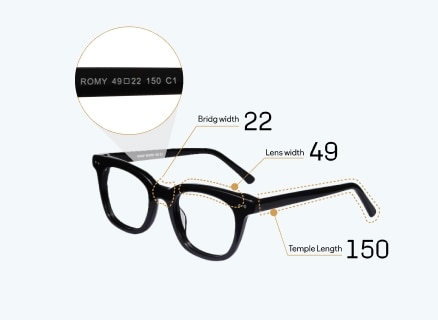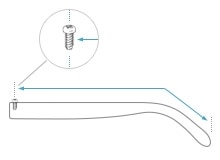Finding the right frame size is an important part of buying eyewear online. Luckily, it’s also super simple! Below is a helpful guide to understanding glasses measurements and sizes when looking for your next pair of eyeglasses or sunglasses.
To ensure your frames fit correctly, you must first determine what frame size is best for you. The best place to start is by taking the measurements of a pair that you already wear and feel comfortable in.
You can usually find the measurements on the inside of the temple of your glasses. Some may also refer to this section as the “arm” of your glasses. The frame measurements normally appear as three numbers separated by dashes — for example, 48-19-140. These three numbers reflect the measurements of different parts of the frames.

From left to right, the numbers tell you the:
- 1. Lens width
- 2. Bridge width
- 3. Temple length
Sometimes a fourth number will be noted on the arm, and this is your lens height. Keep in mind that all these measurements are in millimeters.
-

Lens Width
This is the horizontal width of each lens, measured at its widest point. Also called eye size, it typically ranges from 40 mm to 60 mm.
-

Bridge Width
This is the distance between your two lenses. In short, the bridge width is the space where your frames fit against your nose. The bridge size ranges from 14 mm to 24 mm.
-

Temple (Arm) Length
This is the length of the temple from the hinge to the temple tip, including the bended part that sits on your ear. The arm length is typically 120 mm to 150 mm long.
-

Lens Height
This is the vertical height of your lenses. The measurement for it is taken at the widest point of the lens within the frame. Lens height is especially important when measuring bifocal or progressive lenses.
A Few Helpful Tips for Glasses Measurements
-
Find the Perfect Frame Width

A too-narrow frame will make your face look wider, while a frame that is too wide will make your face look narrower. This is one of the most important factors in finding a pair of glasses that fits your face shape. Find a frame that is slightly wider than your face — no more than a finger width between the temple and your face. Any wider than this is a sign your frames are too wide.
-
Understand Your Temple Length

Temple length is the measurement in millimeters of each “arm” of the frame. This measurement does not vary as much as the others. The most common options are 135 mm, 140 mm, 145 mm, and 150 mm. The temples should fit horizontally and evenly along the sides of your head, and fit comfortably along the outside of your ear.
-
Pick the Right Lens Height and Width

To determine which lens size is right for you, know that a small lens width is 50 mm or less, medium is between 51 mm and 54 mm, and large is any lens wider than 55 mm.
Your eyes should be centered within your lenses. Eyeglass frames that are too wide can make your eyes appear too close together, while narrow frames will give your eyes a wide-set look.
-
Select the Ideal Bridge Width

The distance between a frame’s lenses is its bridge width. The bridge should sit comfortably on your nose. If you have close-set eyes or need a narrow bridge, this number should be smaller. If you have wide-set eyes or want a wide bridge, this number should be larger.
The location of your nose can help determine which frame style works best for you. If your nose is higher on your face, you may want a frame style where the bridge is even with the brow line. If your nose is positioned lower on your face, consider frames with a lower bridge and curved brow line.
Find the Perfect Frame Size!
Check out over 3,000 frame styles to discover which size and shape looks best on you. Once you find your favorite frames, use our lens index guide to help you decide which lenses to get. At Eyebuydirect, we offer 14-Day Free Returns and 365-Day Guarantee overall with every online order to make sure you find the perfect glasses.